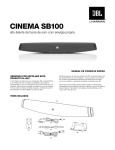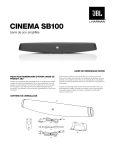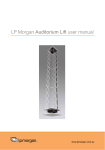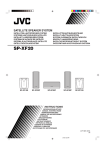Download JBL SB100
Transcript
CINEMA SB100 powered soundbar speaker quick-start guide Thank You For Choosing This JBL® Product We’re confident that this JBL system will provide every note of enjoyment that you expect – and that when you think about purchasing additional audio equipment for your home, car or office, you will once again choose JBL products. The JBL Cinema SB100 powered soundbar speaker is a complete, integrated sound system that will dramatically improve the sound of programs you watch on your television. It can mount on a wall or sit on a shelf and includes all of the cables you need to connect it to your TV and your cable/satellite tuner or disc player. This quick-start guide contains all the information you need to set up, connect and adjust your new speaker system. For more indepth information, go to our Web site: www.jbl.com. Included Items 1x BASS 1x 1x 1x 1x 1x SOUNDBAR REAR-PANEL CONTROLS AND CONNECTIONS Subwoofer Output Connector EQ Switch Optical Input Connector Aux Input Connector SOUNDBAR TOP-PANEL CONTROLS AND REMOTE CONTROL Volume Buttons Power Button Source Surround Button Button Power Button Mute Button Volume Buttons Surround Mode Button BASS Bass Boost Button Source Button Power Switch Power Cord Connector Subwoofer Output connector: If you are using a powered subwoofer (not supplied) with your soundbar, connect it here. Note: This connector outputs a low-pass filtered signal, so connect it to an input on your subwoofer that bypasses the subwoofer’s built-in crossover network. Consult your subwoofer’s owner’s manual for instructions about connections and adjustments. EQ switch: Use this switch to adjust the soundbar’s bass for either wall or table mounting. If you’re mounting the soundbar on a wall with the included wall-mount bracket, set the EQ switch to the “Wall” position for the most natural-sounding bass performance. If you are placing the soundbar on a table, set the EQ switch to the “Table” position for the most natural-sounding bass performance. Optical Input connector (digital): If your TV, disc player or cable/ satellite tuner has an optical digital output, use the included optical cable to connect it here. NOTE: You can connect different source components to the analog and digital connections. Aux Input connection (analog): Use the included stereo 3.5mm to stereo RCA audio cable to connect the stereo analog outputs of your TV, disc player or cable/satellite tuner here. Power switch: Set this switch to the “On” position to activate the soundbar. In normal operation, this switch will be left in the “On” position. See Turning the Soundbar On and Off, on page 5, for more information. Power Cord connector: Connect the included power cord here. See Power Connections, on page 5, for more information. IMPORTANT: Do not connect the power cord to an AC outlet until you have made and verified all other connections. If you will not be using the soundbar for an extended period – for instance, if you’re going on vacation – set the Power switch to the “Off” position. 2 Power button: To turn the soundbar on when it is in the Standby mode, press the Power button on either the soundbar or the remote. (The Power indicator will turn white.) To put the soundbar in the Standby mode, press either Power button while the system is on. (The Power indicator will turn amber.) If you do not press the Power button, the soundbar will automatically go into the Standby mode approximately 10 minutes after the audio signal ceases. NOTE: If you put the soundbar into the Standby mode by pressing the Power button, you must manually turn it on by pressing the Power button again. If the soundbar automatically goes into the Standby mode 10 minutes after the audio signal ceases, it will automatically turn on whenever the soundbar detects an audio signal at either input connection. Mute button (remote control only): Press the Mute button to mute the soundbar. (The Volume +/– indicators both illuminate white.) While the system is muted, press the Mute button again or either Volume button to restore the sound. NOTE: Pressing both of the soundbar’s Volume buttons at the same time while the system is on will mute the system. Pressing either Volume button while the system is muted will restore the sound. Surround Mode button: This button turns the soundbar’s HARMAN Display Surround processing on and off. The Surround button indicator turns amber when HARMAN Display Surround is active, and turns white when HARMAN Display Surround is not active (normal stereo sound). See Surround Mode Buttons, on page 6, for more information. Volume Up/Down buttons: Press the “+” button to increase the volume; press the “–” button to decrease the volume. The buttons illuminate white for a few seconds after being pressed. Source Selector button: This button switches between the sources connected to the Aux (analog) and Optical (digital) inputs. When the Aux input is active, the Source indicator turns white; when the Optical input is active, the Source indicator turns amber. Bass Boost button (remote control only): Press the remote’s Bass Boost button to enhance low-frequency performance. Pressing the Bass Boost button again will return the soundbar’s normal lowfrequency performance. English SOUNDBAR PLACEMENT PLACING THE SOUNDBAR ON A TABLE If your TV is placed on a table, you can place the soundbar on the table directly in front of the TV stand, centered with the TV screen. As long as the surface of the table is flat, the soundbar will rest on its rubber bumpers. 4. A fter reading the Connections section on page 4, bring all the cables through the opening in the bracket, as shown in the illustration below, and connect them to the soundbar. IMPORTANT: Do NOT plug the soundbar’s power cord into an AC outlet at this time. •S et the soundbar’s EQ switch in the “Table” position. See Soundbar Rear-Panel Controls and Connections, on page 2. Bring all Cables Through Bracket Opening WALL-MOUNTING THE SOUNDBAR If your TV is attached to a wall, you can use the included wall-mount bracket to mount the soundbar on the wall directly below the TV screen. 1. D etermine the location for the soundbar on the wall. Make sure that the top of the soundbar will not block your view of the TV screen when it is mounted on the wall. 2. H old the bracket against the wall as a template and mark the locations of the soundbar wall-mount bracket holes on the wall. The two holes should be spaced 4-9/16" (115mm) apart, and the bracket slots are designed to accept 4mm screws. Make sure that the holes are at the same height. See the illustration below. • Set the soundbar’s EQ switch in the “Wall” position, and set the soundbar’s Power switch in the “On” position. See Soundbar RearPanel Controls and Connections, on page 2. 5. Attach the soundbar to the bracket by sliding the bracket’s upper tabs into the slots at the top of the soundbar’s connector section. The bracket’s lower tabs should snap into the slots on the botton of the soundbar (If necessary, rotate the front of the soundbar down slightly to get the tabs into the slots.) Mark Bracket Hole Locations 4-9/16" (115mm) Apart Insert Tabs on Bracket into Slots on Soundbar 3. A ttach the wall-mount bracket to the wall at the locations you marked, using hardware that is appropriate for the wall’s construction and materials. Note that the soundbar weighs 2.5kg (5.5 lb). Be sure to use hardware that can support this weight. Before you tighten the mounting screws all the way, use a carpenter’s level, laser sight or other device to check if the bracket is level. The bracket’s slots allow you to adjust the bracket’s angle on the wall to ensure that it is level. Once the bracket is level, tighten the mounting screws. www.jbl.com 3 CONNECTIONS SOURCE CONNECTIONS Analog: Use the supplied stereo audio cable to connect the soundbar’s Aux (analog) input to your TV’s stereo audio output. If your TV has two sets of audio output jacks, use the set that has a fixed (not variable) output level. This will let you turn your TV’s speakers all the way off while the TV still supplies a constant audio signal to the soundbar. Digital: If your disc player, cable tuner or satellite tuner has an optical digital output, you can use the supplied optical digital audio cable to connect it to the soundbar’s Optical (digital) input. Mono Audio Cable (not supplied) Optical Cable (supplied) NOTE: If your disc player, cable tuner or satellite tuner does not have an optical digital output, you can connect its analog audio output to your TV. The TV will send its audio signal to the soundbar through the analog connection described above. Subwoofer: If you are using an optional powered subwoofer with your soundbar, use a mono audio cable (not supplied) to connect it to the soundbar’s Subwoofer connector. Consult your subwoofer’s owner’s manual for instructions about connections and adjustments. Audio Cable (supplied) TV Powered Subwoofer (optional) AUDIO OUT Disc Player or Cable/Satellite Tuner OPTICAL DIGITAL OUT Remove Caps 4 English POWER CONNECTIONS After verifying that all of the source connections have been made properly, plug the supplied power cord into the soundbar’s Power Cord connector, and plug the other end into an active, unswitched AC outlet. Do NOT plug this cord into the accessory outlet found on some audio components. when the Optical input is active the soundbar’s Source indicator will illuminate amber. Source Button BASS Source Button ADJUSTING THE SYSTEM’S VOLUME Press the soundbar’s or remote’s Volume + and – buttons to raise and lower the system’s volume one step at a time. Hold down the buttons to continuously raise or lower the volume. Volume Volume Buttons Buttons Power Cord (supplied) To Unswitched AC Outlet BASS USING YOUR SOUNDBAR SYSTEM TURNING THE SOUNDBAR ON AND OFF Set the soundbar’s Power switcn to the “On” position. Power Switch For the best sound, we recommend turning your TV’s built-in speakers off. Consult your TV’s owner’s manual to find out how to do this. Press the Power button on either the soundbar or the remote to turn the soundbar on. To put the soundbar in the Standby mode, press either Power button while the soundbar is on. Power Button MUTING THE SYSTEM Momentarily press both of the soundbar’s Volume buttons at the same time, or press the remote’s Mute button to mute the system. (Both Volume indicators illuminate.) Momentarily press either of the soundbar’s Volume buttons or press the remote’s Mute button again to un-mute the system. (The Volume indicators turn off.) Mute Both Volume Button Buttons Power Button BASS BASS If you do not press the Power button, the soundbar will automatically go into the Standby mode approximately 10 minutes after the audio signal ceases. NOTE: If you have put the soundbar into the Standby mode by pressing the Power button, you must manually turn it on by pressing the Power button again. If the soundbar has automatically gone into the Standby mode 10 minutes after the audio signal has ceased, it will automatically turn itself on when it receives an audio signal at either input connection. If you will be away from home for an extended period of time, or if you will not be using the soundbar for an extended period, set the soundbar’s Power switch to the “Off” position. SWITCHING SOURCES Press the soundbar’s or remote’s Source button to switch between the devices you connected to the Aux input and Optical input. When the Aux input is active the soundbar’s Source indicator will illuminate white; CHANGING THE SURROUND MODE Press the soundbar’s or remote’s Surround Mode indicator to switch the sound between normal stereo (the Surround Mode indicator lights white) and HARMAN Display Surround (the Surround Mode indicator lights amber). The HARMAN Display Surround setting will produce a complete surround-sound experience for anyone sitting in front of and several feet away from the soundbar. Although it is particularly effective when watching movies, you can also try the HARMAN Display Surround setting for music. Surround Mode Button Surround Mode Button BASS www.jbl.com 5 BOOSTING THE BASS Press the remote’s Bass Boost button to enhance low-frequency performance, resulting in bass with more impact, which you may prefer while watching movies or listening to music. There is no harm in experimenting with this control. Pressing the Bass Boost button again will return the soundbar’s normal low-frequency performance. BASS Bass Boost Button LEARNING YOUR TV REMOTE’S VOLUME AND MUTE COMMANDS • Press the TV remote’s volume down button while pressing and holding the soundbar’s Volume – button. If the programming was successful the soundbar’s Surround button will change from amber to solid white for one second, then will return to flashing amber. A) Hold Down Soundbar’s Volume – Button B) Press TV Remote’s Volume Down Button • Press the TV remote’s mute button while pressing and holding the soundbar’s Volume + and Volume – buttons at the same time. If the programming was successful the soundbar’s Surround button will change from amber to solid white for one second, then will return to flashing amber. A) Hold Down Soundbar’s Volume + and – Button You can program the soundbar so it will respond to your TV remote’s volume up, volume down and mute commands. This will let you control both the soundbar and your TV with a single remote. Before you begin to program the soundbar, have your TV remote in hand. 1. P ress and hold the soundbar’s Surround button until the button begins flashing amber. Press and Hold Until Button Flashes Amber B) Press TV Remote’s Mute Button 3. When you’re finished, press and hold the soundbar’s Surround button until the button stops flashing amber. The soundbar will now respond to your TV remote’s volume and mute commands. 2. H old your TV’s remote approximately 12” (30cm) from the front of the soundbar and aim the remote directly at the soundbar: Specifications CINEMA SB100 Powered soundbar speaker 30cm (12") TV Remote •P ress the TV remote’s volume up button while pressing and holding the soundbar’s Volume + button. If the programming was successful the soundbar’s Surround button will change from amber to solid white for one second, then will return to flashing amber. A) H old Down Soundbar’s Volume + Button B) P ress TV Remote’s Volume Up Button 6 Low-frequency transducer: One 3" (77mm) cone per channel High-frequency transducer: One 1-1/2" (38mm) tweeter per channel Amplifier power: 30 watts peak per channel Frequency response: 80Hz – 18kHz (-6dB) Power requirement: 100V – 240V, 50Hz/60Hz, 30W Power consumption: <0.5W (standby); 30W (maximum) Dimensions (H x W x D): 4-1/4" x 31-7/8" x 3-5/8" (108mm x 810mm x 92mm) Weight (shipping): 8.4 lb (3.8kg) HARMAN International Industries, Incorporated 8500 Balboa Boulevard, Northridge, CA 91329 USA © 2012 HARMAN International Industries, Incorporated. All rights reserved. JBL is a trademark of HARMAN International Industries, Incorporated, registered in the United States and/or other countries. All Rights Reserved. Features, specifications and appearance are subject to change without notice. Part No. 950-0470-001 Rev: A www.jbl.com















